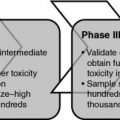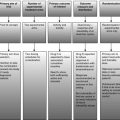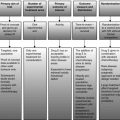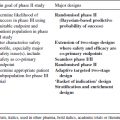7 Sarah Brown This chapter summarises those designs identified via the literature review that may be used for the purpose of evaluating targeted subgroups of patients. As discussed previously, there have been a number of recently published articles in this area that have not been evaluated for inclusion here since they post-date the updated systematic review on which the library is based. Where the incorporation of biomarkers are of particular relevance to a trial design, the designs described within this chapter should be considered; however, we encourage further review of more recent designs specifically intended for trials incorporating biomarkers. A’Hern (2004) A’Hern outlines a single-arm, one-stage (and two-stage) design that takes into account differing response likelihoods for different subgroups of patients, based on the constant arcsine difference (CAD) between upper and lower response limits, which has a constant variance. Null and alternative outcomes are specified for each group and the CAD calculated and assumed constant across each group. In practice, one specifies the null and alternative hypothesis values for a known prognostic group, calculates the corresponding CAD and then calculates equivalent differences for other prognostic groups, considering whether or not these differences would be clinically realistic in other groups. Cut-off values for the distribution of CAD are calculated during the trial, requiring an algorithm to be updated after each patient (towards the end of recruitment), and therefore continuous monitoring is required. Programs are noted as being available from the author to run this in excel. London and Chang (2005) London and Chang incorporate assessment of response rate within strata in their proposed design. Two approaches are proposed: one for which the true proportion of patients in each strata is assumed known (the unconditional approach) and one for which this is assumed unknown (the conditional approach). A simulation algorithm is provided to identify sample size and stopping rules for the unconditional approach, and exact computation is used for the conditional approach. Details are provided in the manuscript; however, both of the approaches will require programming. An estimate of the accrual rate to each stratum is required initially to determine sample size. If, during the course of the trial, the actual stratum proportions are very different to the estimates used, a sample size adjustment may be required during the trial. In general, the conditional approach is recommended, as an accurate estimate of the proportion of patients in each stratum is not required and it is noted to be robust to changes in the proportion of patients within each stratum if the observed proportions are not too far away from the expected proportions. If researchers are very unsure of the likely proportions, a number of differing proportions should be considered and the most conservative sample size taken. A’Hern (2004) A’Hern outlines a single-arm, two-stage (and one-stage) design that takes into account differing response likelihoods for different subgroups of patients, based on the CAD between upper and lower response limits, which has a constant variance. At the end of the first stage the trial may terminate early for lack of activity. Null and alternative outcomes are specified for each group and the CAD calculated and assumed constant across each group. In practice, one specifies the null and alternative hypothesis values for a known prognostic group, calculates the corresponding CAD and then calculates equivalent differences for other prognostic groups, considering whether or not these differences would be clinically realistic in other groups. Cut-off values for the distribution of CAD are calculated during the trial, requiring an algorithm to be updated after each patient (towards the end of recruitment), and therefore continuous monitoring is required. Programs are noted as being available from the author to run this in excel. London and Chang (2005) London and Chang incorporate assessment of response rate within strata in their proposed design. Two approaches are proposed: one for which the true proportion of patients in each strata is assumed known (the unconditional approach) and one for which this is assumed unknown (the conditional approach). A simulation algorithm is provided to identify sample size and stopping rules for the unconditional approach, and exact computation is used for the conditional approach. Details are provided in the manuscript; however, both of the approaches will require programming. An estimate of the accrual rate to each stratum is required initially to determine sample size. If, during the course of the trial, the actual stratum proportions are very different to the estimates used, a sample size adjustment may be required during the trial. In general, the conditional approach is recommended, as an accurate estimate of the proportion of patients in each stratum is not required and it is noted to be robust to changes in the proportion of patients within each stratum if the observed proportions are not too far away from the expected proportions. If researchers are very unsure of the likely proportions, a number of differing proportions should be considered and the most conservative sample size taken. For the two-stage unconditional approach the researcher is required to specify the proportion of the overall type I and type II error rates to be spent in the first stage. Additionally, early termination for lack of activity is permitted. Pusztai et al. (2007) Pustzai and colleagues detail a single-arm two-stage design that considers the response to a single experimental treatment according to biomarker positivity. The goal is to determine whether the drug is likely to have a certain level of activity in unselected patients, and if it is below the level of interest at the end of the first stage, whether a particular patient selection method can enrich the responding population to meet the targeted level of activity in a molecularly selected group. The marker of interest needs to be specified before the trial begins, and more than one marker may be considered (and analyses conducted separately). Sample size and stopping boundaries are calculated as per other two-stage designs (e.g. Simon 1989). The trial is implemented as follows:
Designs evaluating targeted subgroups
7.1 One-stage designs
7.1.1 Binary outcome measure
7.2 Two-stage designs
7.2.1 Binary outcome measure
Stay updated, free articles. Join our Telegram channel

Full access? Get Clinical Tree







